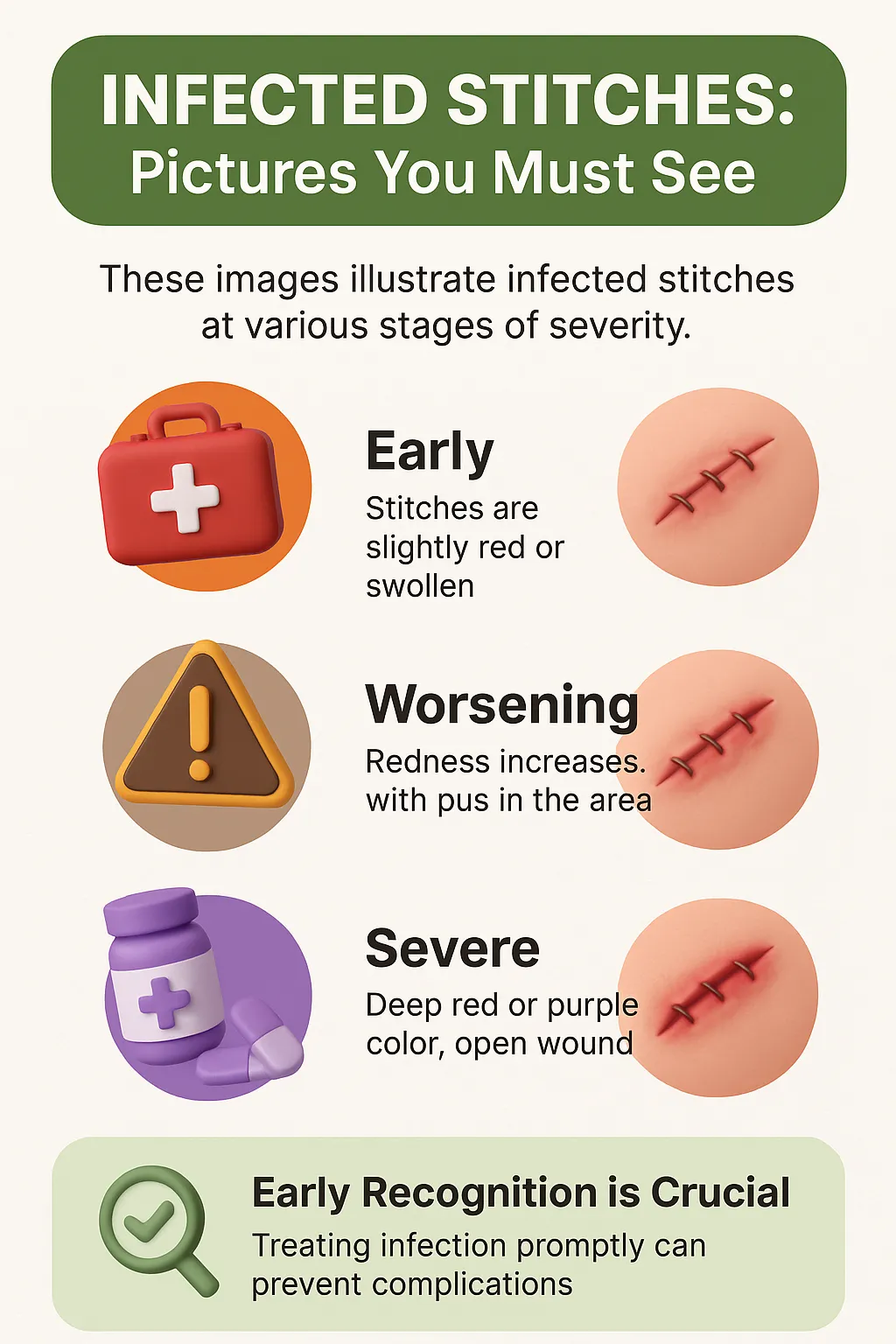If you’ve ever caught yourself staring at your stitches and asking, “Does this look normal?”, you’re not alone. From my experience working with patients after surgery, I know how easily the line between natural healing and the first signs of infection can blur. That’s why this guide goes further than generic advice—you’ll see infected stitches pictures from early to severe stages, paired with professional insights to help you recognize risks, avoid panic, and take the right steps for safe healing.
Top Takeaways
- Key warning signs: Redness, swelling, pus, odor, fever, and increasing pain.
- The scope of the problem: About 500,000 surgical site infections (SSIs) occur in the U.S. each year.
- Timing is critical: Early action can prevent serious complications.
- Awareness vs. treatment: Pictures guide awareness, but medical care ensures recovery.
What Infected Stitches Pictures Show at Each Stage
Studying pictures of infected stitches helps you distinguish normal recovery from potential danger.
- Early Stage: Mild redness and tenderness that worsens instead of improving.
- Moderate Stage: Spreading redness, swelling, warmth, or cloudy discharge.
- Severe Stage: Thick pus, strong odor, fever, and severe pain requiring urgent medical care.
By comparing these images, you’ll see how infections progress and why early recognition is essential. These visuals not only help you spot red flags but also reassure you about what’s still within the range of normal healing.
If your wound resembles advanced examples—especially if you also have fever or spreading pain—it’s time to call a medical professional right away.
Expert Insight
“In my clinical experience, the smallest changes—like drainage turning cloudy or redness creeping beyond the sutures—are often the first signs patients overlook. Having infected stitches pictures that show each stage can make all the difference between catching a problem early and facing serious complications.”
Case Studies & Real-World Examples
Catching Infection Early – Maria’s Story
- 42-year-old recovering from abdominal surgery.
- On day 3, noticed redness and swelling.
- Compared to early infection pictures and spotted spreading redness.
- Called her surgeon and was prescribed antibiotics.
- Result: Infection stopped before becoming severe.
Delaying Care – James’s Story
- 29-year-old after knee surgery.
- Mistook worsening pain for “normal healing.”
- By day 7, had thick yellow discharge and odor, consistent with severe infection pictures.
- Required in-office cleaning and a strong antibiotic course.
- Later admitted: “If I had looked at reference pictures sooner, I would have acted faster.”
Key Insight: Subtle changes in the early stage can escalate quickly. Patients who use infection pictures as a reference tend to act sooner and recover better.
Supporting Statistics & Insights
- SSIs account for ~20% of all healthcare-associated infections and can raise mortality risk by 2–11×.
- Each SSI adds an average of 9.7 hospital days and more than $20,000 in costs, contributing to ~$3.3 billion annually.
Insight: These statistics mirror what I’ve seen first-hand—catching early-stage signs saves patients from prolonged recovery and high costs.
Final Thought & Opinion
Viewing infected stitches pictures isn’t about fear—it’s about knowledge. Many patients ignore warning signs, assuming pain and redness are normal. But those who compare their healing to trustworthy images and take action early are the ones who recover faster and avoid complications.
My opinion: Reliable stage-by-stage pictures, combined with prompt medical guidance, are one of the most effective tools for patient safety. Knowledge plus vigilance equals better outcomes.
Next Steps
- Compare: Look at early-to-severe infection pictures.
- Check: Watch for red flags like spreading redness, pus, or fever.
- Document: Take daily photos of your wound.
- Contact: Call your provider if symptoms worsen or match severe stages.
- Prevent: Wash hands, change dressings properly, and follow care instructions.
Remember: Early recognition and quick action can prevent an infection from progressing to severe stages.
Frequently Asked Questions (FAQs)
What do early-stage infected stitches look like?
Early infections usually show redness, mild swelling, or tenderness that gets worse instead of better. Drainage may begin to look cloudy.
What do moderate-stage infected stitches look like?
At this stage, infection often causes spreading redness, increased swelling, warmth around the site, and thicker or discolored discharge.
What do severe-stage infected stitches look like?
Severe infection is marked by pus, foul odor, intense pain, fever, and redness spreading far beyond the incision line. Medical attention is urgent.
Why are early-to-severe infected stitches pictures useful?
They provide visual context for spotting red flags, helping patients understand what’s normal versus what requires immediate medical care.
What should I do if my stitches resemble severe infection pictures?
Document changes with photos, avoid touching or removing stitches, and contact your doctor or surgeon right away to prevent complications.
When examining infected stitches pictures you must see: early to severe stages, it’s important to understand how external factors like environment and air quality can influence recovery. Just as early redness or swelling around stitches should not be ignored, maintaining a clean space with proper air circulation helps reduce the risk of complications. High-quality filtration products such as the Day and Night 20x20x5 Air Filters MERV 11 are designed to capture harmful particles that might aggravate healing conditions. For households seeking professional help to keep their systems running efficiently, services like HVAC Repair Companies ensure that clean air delivery is consistent and reliable. Affordable solutions, including the 20x20x1 Pleated Furnace Filters and the higher-efficiency 20x20x1 MERV 13 Pleated HVAC AC Furnace Air Filters (12-Pack), can help minimize allergens and bacteria in the air, supporting a healthier environment for wound care. Even cost-effective choices such as the Furnace Filter listing on eBay provide practical options to maintain clean indoor conditions, complementing proper medical attention and wound monitoring during recovery.




